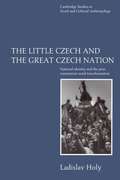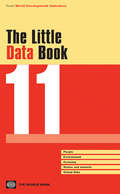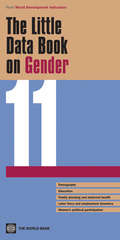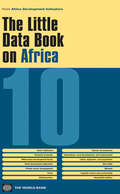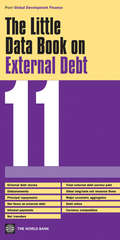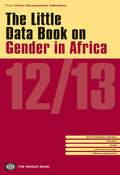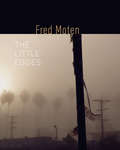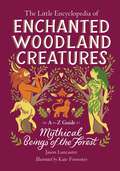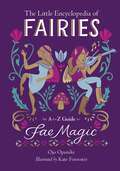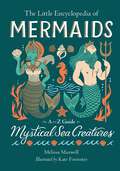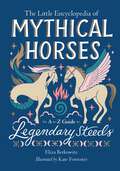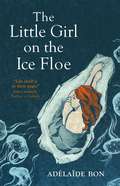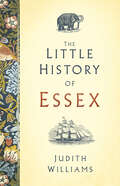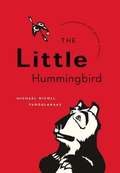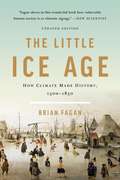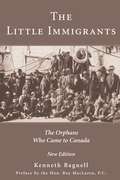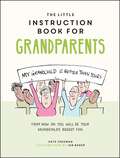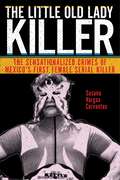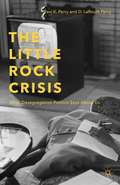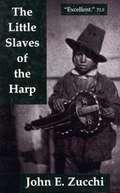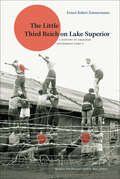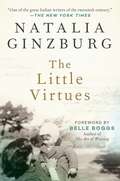- Table View
- List View
The Little Czech and the Great Czech Nation: National Identity and the Post-Communist Transformation of Society
by Ladislav HolyThe book intends to investigate the specific ways in which Czech cultural meanings and the accompanying nationalist sentiments have affected life under communism, its overthrow, and the political and economic transformation of post-communist society.
The Little Data Book 2011
by World BankThis pocket-sized reference on key development data for over 200 countries provides profiles of each country with 54 development indicators about people, environment, economy, technology and infrastructure, trade, and finance.
The Little Data Book On Gender 2011
by the editors at The World BankThis handy pocket guide is a quick reference for users interested in the gender statistics. The book presents gender-disaggregated data for more than 200 countries in an easy country-by-country reference on demography, education, health, labor force, political participation and the Millennium Development Goals. The book s summary pages cover regional and income group aggregates.
The Little Data Book on Africa 2010
by World Bank'The Little Data Book on Africa 2010' is a pocket edition of 'Africa Development Indicators 2010'. It contains some 115 key indicators on economics, human development, governance, and partnership and is intended as a quick reference for users of the 'Africa Development Indicators 2010' book and African Development Indicators Online. The country tables present the latest available data for World Bank member countries in Africa.
The Little Data Book on Africa 2012/2013
by World BankThe Little Data Book on Africa 2012/2013 is a pocket edition of Africa Development Indicators 2012/2013. It contains some 115 key indicators on economics, human development, governance, and partnership and is intended as a quick reference for users of the Africa Development Indicators 2010 book and African Development Indicators Online. The country tables present the latest available data for World Bank member countries in Sub-Saharan Africa, covering about 1,700 indicators from 1961 to 2011. Key themes are : - Basic indicators- Drivers of growth- Participating in growth- Capable states- PartnershipsDesigned to provide all those interested in Africa with quick reference and a reliable set of data to monitor development programs and aid flows in the region, this is an invaluable pocket edition reference tool for analysts and policy makers who want a better understanding of the economic and social developments occurring in Africa. For free access to Africa Development Indicators online, please visit http://data. worldbank. org/data-catalog.
The Little Data Book on External Debt 2011
by the editors at The World Bank'The Little Data Book on External Debt' provides a quick reference for users interested in external debt stocks and flows, major economic aggregates, key debt ratios, and the currency composition of long-term debt for all countries reporting through the Debtor Reporting system. A pocket edition of 'Global Development Finance 2011, Summary and Country Tables', it contains statistical tables for 135 countries as well as summary tables for regional and income groups.
The Little Data Book on Gender in Africa 2012/13
by World BankThe Little Data Book on Gender in Africa 2012/13 provides a summary collection of gender statistics on Africa available in one volume. It contains 60 indicators, covering 53 African countries. Additional data may be found on the companion CD-ROM or online, covering about 1,700 indicators from 1961 to 2011. Key themes are : - Basic demographic indicators- Education- Health- Labor force and wages- Women's empowermentDesigned to provide all those interested in Africa with quick reference and a reliable set of data to monitor development programs and aid flows in the region, this is an invaluable pocket edition reference tool for analysts and policy makers who want a better understanding of the economic and social developments occurring in Africa. For free access to Africa Development Indicators online, please visit http://data. worldbank. org/data-catalog.
The Little Database: A Poetics of Media Formats (Electronic Mediations #64)
by Daniel Scott SnelsonA poetics for reading the everyday objects that populate a hard drive Bespoke online archives like PennSound and Eclipse host an astounding array of &“old media&” artifacts, posing a handcrafted counterpoint to the immense databases aggregated by digital titans like Google and Facebook. In The Little Database, Daniel Scott Snelson argues for the significance of these comparatively &“small&” collections, exploring how digital archives dramatically transform the artifacts they host and how they might help us better understand our own private collections in turn. Examining curated collections such as Textz, UbuWeb, and the Electronic Poetry Center, Snelson explores media-specific works by poets and artists, including William Carlos Williams, Tracie Morris, bill bissett, Nam June Paik, and Vicki Bennett. He develops creative tools and contingent methods for reading cultural data, whether found on the internet or in our own collections of TXT, JPG, MP3, and MOV artifacts, presenting case studies to show how these objects have come to find revised meaning in their digital contexts. Along the way, experimental poetic interludes give readers practical entry points into the creative practice of producing new meanings in any given little database. Inventive and interdisciplinary, The Little Database grapples with the digitized afterlives of cultural objects, showing how the past is continually reconfigured to shape the present. It invites readers to find playful and personal means for unpacking their own data collections, in the process discovering idiosyncratic ways to explore and connect with digital archives. Retail e-book files for this title are screen-reader friendly with images accompanied by short alt text and/or extended descriptions.
The Little Edges (Wesleyan Poetry Series)
by Fred MotenThe Little Edges is a collection of poems that extends poet Fred Moten's experiments in what he calls "shaped prose"--a way of arranging prose in rhythmic blocks, or sometimes shards, in the interest of audio-visual patterning. Shaped prose is a form that works the "little edges" of lyric and discourse, and radiates out into the space between them. As occasional pieces, many of the poems in the book are the result of a request or commission to comment upon a work of art, or to memorialize a particular moment or person. In Moten's poems, the matter and energy of a singular event or person are transformed by their entrance into the social space that they, in turn, transform. An online reader's companion is available at http://fredmoten.site.wesleyan.edu.
The Little Encyclopedia of Enchanted Woodland Creatures: An A-to-Z Guide to Mythical Beings of the Forest (The Little Encyclopedias of Mythological Creatures)
by Jason LancasterRunning the gamut from A-to-Z and spanning the globe from the forest glens of Romania to the mountain aeries of Colorado, The Little Encyclopedia of Enchanted Woodland Creatures brings together all the most magical creatures of the forest. Naughty and nice, real and fictional, the menagerie of creatures included in this book encompass multiple world mythologies and cultures. This little encyclopedia features more than 90 famous woodland creatures from around the world, including: Andvari—a magical ring wearing dwarf from Norse Mythology who lives under a waterfall Baba Yaga—one of the most potent witches in all of folklore, said to live deep in the Russian forest Glawackus—a fearsome creature of the American woods that looks like a mix between a bear, a lion, and a panther Sasabonsam—creatures from Ghanaian folklore with red hair and iron teeth who are said to feast on those who wander past their forest home Also filled with descriptions of other powerful forest beings like dryads, fauns, elves, and gnomes, this information-packed guide includes gorgeous line drawings throughout.
The Little Encyclopedia of Fairies: An A-to-Z Guide to Fae Magic (The Little Encyclopedias of Mythological Creatures)
by Ojo OpanikeFrom the mountains of Northern Italy to the remote forests of Nigeria, diverse fairies from around the world come together in this little encyclopedia . . . Naughty and nice, unpredictable and typically tiny, fairies remain one of the most enduring folk creatures, featuring in mythologies across cultures and throughout history. This little encyclopedia rounds up more than 90 fairies from around the world, including: The Alux, a fairy of Mayan legend whom farmers called on for rain The Banshee, a fairy of Irish lore whose cries were associated with death The Hulijing, a fairy from Chinese mythology, who could shape-shift into a fox The Yumbo, a silver-haired Senegalese fairy, who dances in moonlight And so many more! With detailed illustrations throughout, this book offers a fun and information-packed guide to these small yet powerful beings.
The Little Encyclopedia of Mermaids: An A-to-Z Guide to Mystical Sea Creatures (The Little Encyclopedias of Mythological Creatures)
by Melissa MaxwellThe Little Encyclopedia of Mermaids is an A-to-Z compendium that spans the globe—from the Isle of Man to the depths of the Sea of Japan—weaving together famous and popular tales of everyone's favorite mythical sea creature. Naughty and nice, real and fictional, the menagerie of creatures included in this book run the gamut of world mythologies and cultures. This little encyclopedia features more than 90 famous mermaids including: Atargatis—a mermaid from ancient Syria who was a goddess before she fell in love with a mortal Blue Men of the Minch—a group of riddle-loving merfolk who have the power to summon storms and capsize ships Little Mermaid—everyone's favorite mermaid princess, who gives up her voice for a chance at love Ningyo—a gruesome sea creature from Japanese folkore that can bring dangerous storms and other misfortune Filled with tales of star-crossed mermaids and vengful sea gods and goddesses, this information-packed guide includes gorgeous line drawings throughout.
The Little Encyclopedia of Mythical Horses: An A-to-Z Guide to Legendary Steeds (The Little Encyclopedias of Mythological Creatures)
by Eliza BerkowitzFrom Arthurian legend to tales of ancient China, horses have traversed the world alongside humans for centuries, and their heroic adventures are gathered here in this one-of-a-kind little encyclopedia . . . Beloved for their grace, strength, and untamed beauty, horses have always loomed large in our imaginations, featuring in mythologies across cultures and throughout history. This little encyclopedia rounds up more than 50 mythical horses from around the world, including: Bai Long Ma, part dragon and part horse, of the Chinese classic Journey to the West Balius and Xanthus, Achilles's horses who fought in the Trojan War Pegasus, a winged stallion and child of the Greek god Poseidon Sleipnir, a war horse belonging to great Norse god Odin And so many more! With detailed illustrations throughout, this book pays tribute to some of our most formidable equine friends.
The Little Girl on the Ice Floe
by Adélaïde Bon"Life itself is in these pages: in this candid, poetic style there is storytelling of real quality" - LEILA SLIMANI, author of LullabyA powerful and personal account of the devastating consequences of childhood rape: a valuable voice for the #MeToo conversation.Adélaïde Bon grew up in a wealthy neighborhood in Paris, a privileged child with a loving family, lots of friends and seemingly limitless opportunity lying ahead of her. But one sunny afternoon, when she was nine years old, a strange man followed her home and raped her in the stairwell of her building. She told her parents, they took her to the police, the fact of the crime was registered ... and then a veil was quietly drawn over that part of her childhood, and life was supposed to go on.Except, of course, it didn't.Throughout her adolescence and young adulthood, Adélaïde struggles with the aftermath of the horror of that afternoon in 1990. The lingering trauma pervades all aspects of her life: family education, friendships, relationships, even her ability to eat normally. And then one day, many years later, when she is married and has a small son, she receives a call from the police saying that they think they have finally caught the man who raped her, a man who has hidden in plain sight for decades, with many other victims ready to testify against him. The subsequent court case reveals Giovanni Costa, the stuff of nightmares and bogeymen, finally vanquished by the weight of dozens and dozens of emotional and horrifying testimonies from all the women whose lives and childhoods he stole.
The Little History of Essex
by Judith WilliamsThere is nothing ‘little’ about the history of Essex! However, this small volume condenses that fascinating, rich history into a collection of stories and facts that will make you marvel at the events our county has witnessed. Discover the development of ship building at Harwich, the silk and woollen industries in central Essex, the fortunes of Chelmsford and Colchester and the rise of seaside resorts at Southend and Clacton. Take a journey through Essex’s historic struggles and celebrations or jump in to the era of your choice to discover the who, what and why of our county’s history.
The Little Hummingbird
by Michael Nicoll YahgulanaasThis children's book is based on a South American indigenous story about a courageous hummingbird who defies fear and expectations in her attempt to save the forest from fire. The story is supplemented by a natural and cultural history of hummingbirds, as well as an inspiring message. The Artist complements this optimistic tale that encourages everyone to take responsibility for their home and the planet.
The Little Ice Age: How Climate Made History 1300-1850
by Brian FaganOnly in the last decade have climatologists developed an accurate picture of yearly climate conditions in historical times. This development confirmed a long-standing suspicion: that the world endured a 500-year cold snap-The Little Ice Age-that lasted roughly from A.D. 1300 until 1850. The Little Ice Age tells the story of the turbulent, unpredictable and often very cold years of modern European history, how climate altered historical events, and what they mean in the context of today's global warming. With its basis in cutting-edge science, The Little Ice Age offers a new perspective on familiar events. Renowned archaeologist Brian Fagan shows how the increasing cold affected Norse exploration; how changing sea temperatures caused English and Basque fishermen to follow vast shoals of cod all the way to the New World; how a generations-long subsistence crisis in France contributed to social disintegration and ultimately revolution; and how English efforts to improve farm productivity in the face of a deteriorating climate helped pave the way for the Industrial Revolution and hence for global warming. This is a fascinating, original book for anyone interested in history, climate, or the new subject of how they interact.
The Little Immigrants: The Orphans Who Came to Canada
by Kenneth BagnellThe Little Immigrants is a tale of compassion and courage and a vivid account of a deep and moving part of Canadian heritage. In the early years after Confederation, the rising nation needed workers that could take advantage of the abundant resources. Until the time of the Depression, 100,000 impoverished children from the British Isles were sent overseas by well-meaning philanthropists to solve the colony’s farm-labour shortage. They were known as the "home children," and they were lonely and frightened youngsters to whom a new life in Canada meant only hardship and abuse. This is an extraordinary but almost forgotten odyssey that the Calgary Herald has called, "One of the finest pieces of Canadian social history ever to be written." Kenneth Bagnell tells "an affecting tale of Dickensian pathos" (Vancouver Sun) that is "excellent … well organized, logical, clearly written, [and] suspenseful" (The Edmonton Journal).
The Little Instruction Book for Grandparents: Tongue-in-Cheek Advice for Surviving Grandparenthood
by Kate FreemanSo you’re a grandparent! One of the most magical roles you’ll ever have – but also one of the messiest. But never fear: this indispensable handbook is here to guide you through the pleasures and pitfalls of grandparenthood, and, most importantly, teach you how to keep the grandkids quiet while you catch up on your nap-time.
The Little Instruction Book for Grandparents: Tongue-in-Cheek Advice for Surviving Grandparenthood
by Kate FreemanSo you’re a grandparent! One of the most magical roles you’ll ever have – but also one of the messiest. But never fear: this indispensable handbook is here to guide you through the pleasures and pitfalls of grandparenthood, and, most importantly, teach you how to keep the grandkids quiet while you catch up on your nap-time.
The Little Old Lady Killer: The Sensationalized Crimes of Mexico's First Female Serial Killer (Alternative Criminology #20)
by Susana Vargas CervantesThe surprising true story of Mexico’s hunt, arrest, and conviction of its first female serial killerFor three years, amid widespread public outrage, police in Mexico City struggled to uncover the identity of the killer responsible for the ghastly deaths of forty elderly women, many of whom had been strangled in their homes with a stethoscope by someone posing as a government nurse. When Juana Barraza Samperio, a female professional wrestler known as la Dama del Silencio (the Lady of Silence), was arrested—and eventually sentenced to 759 years in prison—for her crimes as the Mataviejitas (the little old lady killer), her case disrupted traditional narratives about gender, criminality, and victimhood in the popular and criminological imagination.Marshaling ten years of research, and one of the only interviews that Juana Barraza Samperio has given while in prison, Susana Vargas Cervantes deconstructs this uniquely provocative story. She focuses, in particular, on the complex, gendered aspects of the case, asking: Who is a killer? Barraza—with her “manly” features and strength, her career as a masked wrestler in lucha libre, and her violent crimes—is presented, here, as a study in gender deviance, a disruption of what scholars call mexicanidad, or the masculine notion of what it means to be Mexican. Cervantes also challenges our conception of victimhood—specifically, who “counts” as a victim.The Little Old Lady Killer presents a fascinating analysis of what serial killing—often considered “killing for the pleasure of killing”—represents to us.
The Little Rock Crisis
by Ravi K. Perry D. Larouth PerryThe Little Rock Crisis describes the power of direct and learned memories of the 1957 desegregation crisis in Little Rock, Arkansas. Personal, dramatic experiences of Little Rockians – known and unknown – reflect on the impact of the crisis on their lives in the 21st century. Linking individual memories to collective action through the lens of social appropriation, the book explores how the crisis has impacted the political behavior of Little Rockians. Oral histories and surveyresearch show how the events from the tumultuous 1950s in Little Rock school politics, inform and direct the national political engagement and local community involvement of diverse residents.
The Little Slaves of the Harp: Italian Child Street Musicians in Nineteenth-Century Paris, London, and New York (McGill-Queen's Studies in Ethnic History #13)
by John E. ZucchiDuring the nineteenth century child musicians could be seen performing in the streets of cities across Europe and North America. Although they came from a number of countries, Italians were most associated with street music. In The Little Slaves of the Harp John Zucchi tells the story of the thousands of Italian children who were indentured to padrone and then uprooted from their villages in central and southern Italy and taken to Paris, London, and New York to perform as barrel-organists, harpists, violinists, fifers, pipers, and animal exhibitors.
The Little Third Reich on Lake Superior: A History of Canadian Internment Camp R
by Ernest Robert ZimmermannAn in-depth history of one of Canada’s World War II internment camps that held both Nazis and anti-Nazis alike.For eighteen months during the Second World War, the Canadian military interned 1,145 prisoners of war in Red Rock, Ontario (about 100 kilometres northeast of Thunder Bay). Camp R interned friend and foe alike: Nazis, anti-Nazis, Jews, soldiers, merchant seamen, and refugees whom Britain feared might comprise Hitler’s rumoured “fifth column” of alien enemies residing within the Commonwealth. For the first time and in riveting detail, the author illuminates the conditions in one of Canada’s forgotten POW camps. Backed by interviews and meticulous archival research, Zimmermann fleshes out this rich history in an accessible, lively manner. The Little Third Reich on Lake Superior will captivate military and political historians as well as non-specialists interested in the history of POWs and internment in Canada.“Most of us have an image of what prisoner of war camps looked like, either from documentary footage about Nazi POW camps, or feature films about World War II, or television situation comedies. The Little Third Reich on Lake Superior shatters all of those stereotypes and, through diligent assembly of public records, multiple library archives and personal interviews, gives us an in-depth picture of a Canadian internment camp. All of this is skillfully organized in a reader-friendly, chronological way.” —Michael Sabota, Chronicle Journal“The study shines light on the lesser-known Canadian prisoner of war (POW) camps in World War II. In this well-researched study, Zimmermann describes not only Camp R, but the inmates, guards, military command structure, politicians, and general political environment in Canada and Britain. . . . The work is easy to read and deftly supported by a broad array of sources. Zimmermann’s analysis encompasses Canadian and British history. . . . The Little Third Reich on Lake Superior sets a high standard for future research into civilian internment camps.” —Anna Marie Anderson, The Journal of Military History
The Little Virtues: Essays
by Natalia Ginzburg Belle BoggsIn this collection of her finest and best-known short essays, Natalia Ginzburg explores both the mundane details and inescapable catastrophes of personal life with the grace and wit that have assured her rightful place in the pantheon of classic mid-century authors. Whether she writes of the loss of a friend, Cesare Pavese; or what is inexpugnable of World War II; or the Abruzzi, where she and her first husband lived in forced residence under Fascist rule; or the importance of silence in our society; or her vocation as a writer; or even a pair of worn-out shoes, Ginzburg brings to her reflections the wisdom of a survivor and the spare, wry, and poetically resonant style her readers have come to recognize. "A glowing light of modern Italian literature . . . Ginzburg's magic is the utter simplicity of her prose, suddenly illuminated by one word that makes a lightning streak of a plain phrase. . . . As direct and clean as if it were carved in stone, it yet speaks thoughts of the heart.' — The New York Times Book Review
